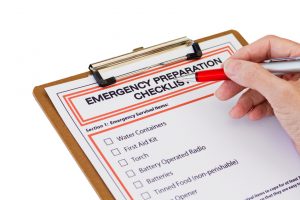California has more than its share of natural disasters: earthquakes, wildfires, and mudslides, to name several. The 2017 California wildfire season had a record 9,133 fires that burned more than 1.3 million acres, and in January 2018, severe mudslides shut down about 30 miles of Highway 101 between Northern and Southern California. Although California workplaces can’t control these and other unexpected occurrences, they can successfully survive such events, provided they invest the time and resources needed to be prepared. So, what actions should you take to be ready to combat a disaster in the Golden State?

Cal/OSHA Requirements
Emergency action plan. First on the list is that workplaces should prepare a written emergency action plan (EAP) to ensure employee safety from fire and other emergencies. Although Cal/OSHA does not explicitly require every business to have an EAP, most businesses need one to meet local county or city requirements. Failure to have this plan is a violation frequently cited by Cal/OSHA. The EAP regulation requires these minimum plan standards:
- Procedures for reporting the emergency
- Procedures for emergency evacuation, including the types of evacuation and exit route assignments
- Procedures for employees who remain to operate critical operations before they evacuate
- Procedures to account for all employees when the evacuation has been completed
- Procedures for employees performing rescue or medical duties
- The establishment of an employee alarm system that complies with state standards
- Training of employees on the EAP
Exit routes. It’s key that workplaces comply with the California requirements for exit routes that are more stringent than their federal counterparts. The state standards cover everything from exit door locations, distance to exits, exit width, head room, and exit signs to how decorative materials located in passageways to exits must be made of nonflammable material. An evacuation plan is only effective if the exit routes are accessible, and these strict state standards are geared toward ensuring the swift and safe exit of employees.

Other Ways to Prepare for an Emergency
The state Governor’s Office of Emergency Services provides emergency preparedness tips. For example, it suggests that in the event of an earthquake, employees can improve their safety by following these five steps:
- Determine if the workplace is in an area of risk for an earthquake.
- Be familiar with the company’s emergency plan.
- Know evacuation routes and locations deemed safe.
- Keep a pack of personal supplies (including walking shoes) that can be grabbed quickly.
- Keep a list of emergency numbers handy.
Cal/OSHA Summit
To learn more about California’s requirements for emergency situations, rules that may be on the horizon, and what you can do to prepare for an unexpected disaster at your facility, attend Planning for the Unforeseen Crisis: Emergency Preparedness in the Golden State, presented by Matt Hochstein of Hagerty Consulting, at BLR’s upcoming Cal/OSHA Summit 2018.
The Cal/OSHA Summit, which will be held from October 17–19 in San Diego, is a leading state-specific event for California employers and safety professionals to get cutting-edge developments on new safety regulations, compliance strategies, and management tactics. Attendees will learn proven strategies for acing Cal/OSHA inspections, avoiding the most common compliance mistakes, delivering excellent safety performance results, and building a strong culture of safety throughout their organization. Register now.
